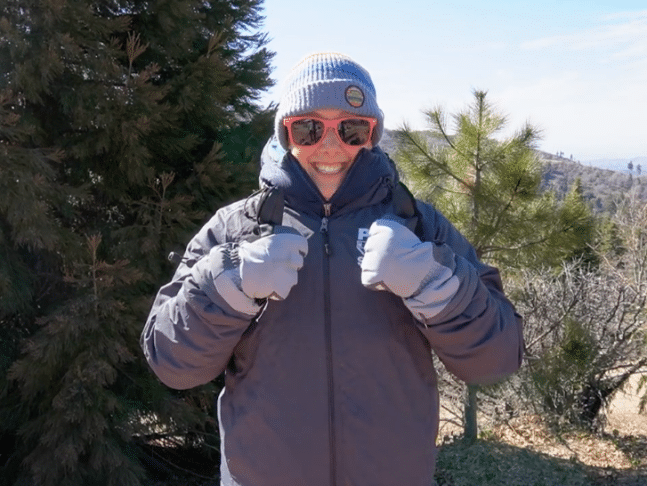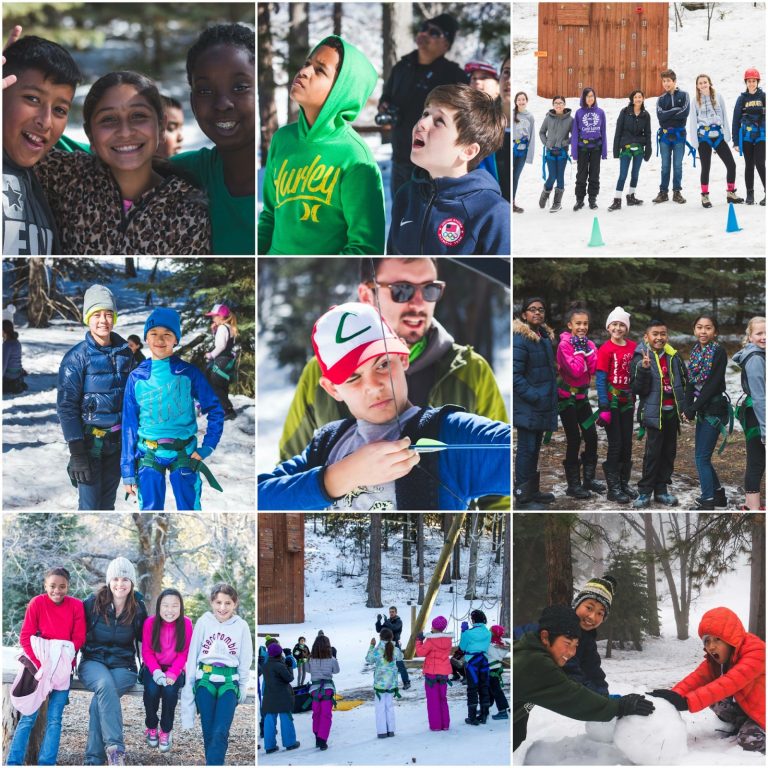While science camp is about learning experiences, getting outside to try new things, and bonding with classmates it is also about traveling to a new environment. Science camp for many students may be their first experience in that particular environment and climate. Whether it’s the mountains or the beach these experiences last a lifetime and remain favorite memories for many individuals throughout years to come. Unfortunately, many students do not have the ability to travel and leave their hometown until they board that bus for science camp. That trip may result in a student breathing in the fresh mountain air for the first time, seeing those breathtaking mountain views that go on for miles or touching snow for the very first time. Situated at 6,000 feet we are lucky enough to see all 4 seasons! Whether it’s a students’ first time in the snow or their tenth time, experiencing that with their closest friends is something they’ll never forget!
What does winter look like at Pali?
- Typically, average temperatures in December, January & February are around 45 degrees during the day and drop 10-20 degrees at night.
- Inclement weather could be snow, rain, fog, or just cold temperatures.
- We also have beautiful sunny days where it gets up to 60 degrees and students get warm enough to wear just a t-shirt and jeans.
A trip to Pali Institute can be a great opportunity for you to share new experiences with your students. Regardless of the weather, students have memorable and fun experiences that they will talk about for years to come!
Preparing With the Team
Transportation
- CHP regulations require vehicles carry chains during the winter weather months. Buses are included in this regulation and fortunately bus drivers are trained in inclement weather driving.
- Chat with your bus company prior to booking to ensure they are familiar with this and understand your concerns.
Is your bus company not meeting your needs? Contact Pali Institute and we’d be more than happy to refer you to one of the many companies our returning schools rely on every year!
Selecting Classes
- Start to think about and plan which classes you want. Choosing a variety of indoor and outdoor classes help offer students breaks from the cold.
- A day of both indoor and outdoor classes might look like CSI: Pali, High Ropes, Aerodynamics, Forest Ecology, and Owl Pellet Dissection.
- Temperatures at Pali drop at night! Even if students are outside all day long, having them inside for that last class during the coldest part of their stay makes a big difference. Not only does this allow students to warm up after a chilly day outside but it keeps them excited about learning!
Questions about which classes at Pali Institute take place indoors? Give us a call and we’d be happy to help!
Planning With Families
Often families have the question of, do I need a winter jackets for my child? While that will keep them warm, students can also use clothes they have to dress in layers, keeping them warm without an additional purchase.
How to dress in Layers to Keep Warm and Dry
- Base Layer – this is your next to skin layer. This can be as simple as a long sleeve on top and leggings or thermals on bottom. This layer provides a base in making sure the camper remains warm. Many times, these are items the camper currently owns and wears regularly.
- Middle Layer – this is your second layer and your insulation. This is a fleece or hoody on top and jeans or cotton sweat pants on bottom. This layer is important because it’s the layer that keeps the camper warm. Again, many times, these are items the camper currently owns and wears regularly.
- Shell Layer – this is your third and final layer and most importantly, your weather protection. This is a raincoat or waterproof jacket on top and waterproof or athletic pants on bottom. This layer is critical because it’s what keeps the camper dry. Not only does this keep the camper dry but it’s easily removed and stored in a backpack if it’s not needed, remaining available for later in the day.
- Ideally, campers will have a pair of snow boots or rain boots that are waterproof to keep their feet dry and warm. However, if they don’t plastic bags will work. The camper simply places the bags over their socks and inside their shoes so that that their feet remain dry and warm. This is a long time camping tool that is used often up here at Pali!
- A set of mittens or gloves will make a huge difference! If a camper is able to keep their hands warm, that helps to keep their entire body warm and makes for a much more pleasant experience.
If a student doesn’t have warm layers or warmer items, what are some other options?
- Are there any local thrift stores in your area? Often times, they are full of gently worn items that may have only been used a few times at an incredibly affordable rate.
- Children outgrow things fast, are there families in the community who can donate warm layers or boots?
- Are there any family members, friends, or neighbors that you can borrow a few things from? Mom’s winter coat that is a little too big will save you from going out and buying a new coat that may only get used for one week.
Check the weather for packing the week before your arrival date: check out our zip code (92382) on Weather.com. Pali is here to help! Take a deep breath and use our handy pack list that is posted online. Questions? Give us a call!
During Your Trip
Make an effort to be present, having a familiar face and knowing their teacher is experiencing the weather with them will help students to be more comfortable. Most importantly, keep positive! Just as they do inside the classroom, students will easily mirror the enthusiasm of their teachers at Pali! Finally, if schedule adjustments do need to be made in the case of inclement weather or precipitation, please let us know and we’d be happy to help.
About Pali Institute
At Pali Institute our mission is to introduce experiential education to young people by providing progressive learning experiences that extend far beyond classroom walls. Through our innovative curriculum and professional outdoor staff, students will experience the thrill of seeing, touching and learning about the world around them. At Pali Institute, we bring textbooks to life!

